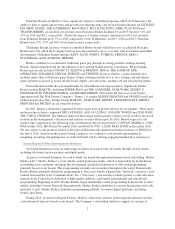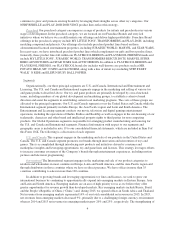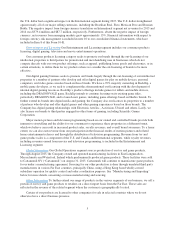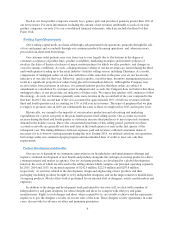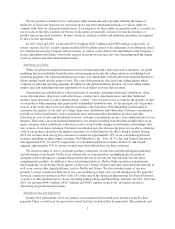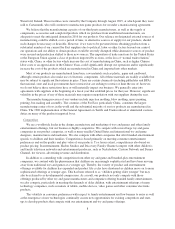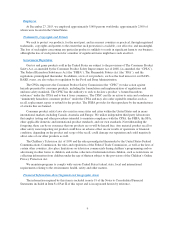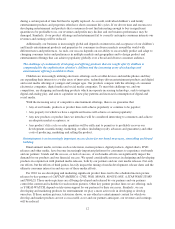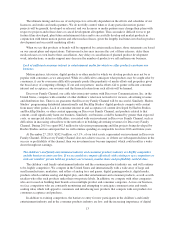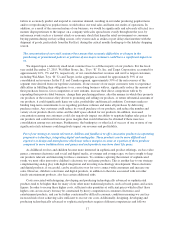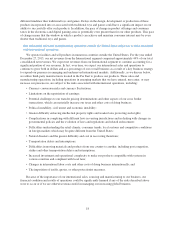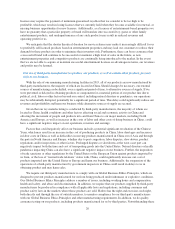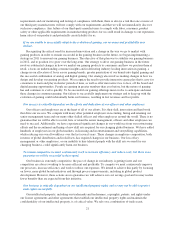Hasbro 2015 Annual Report Download - page 23
Download and view the complete annual report
Please find page 23 of the 2015 Hasbro annual report below. You can navigate through the pages in the report by either clicking on the pages listed below, or by using the keyword search tool below to find specific information within the annual report.during a certain period of time but then be rapidly replaced. As a result, individual children’s and family
entertainment products and properties often have short consumer life cycles. If we devote time and resources to
developing entertainment and products that consumers do not find interesting enough to buy in significant
quantities to be profitable to us, our revenues and profits may decline and our business performance may be
damaged. Similarly, if our product offerings and entertainment fail to correctly anticipate consumer interests our
revenues and earnings will be reduced.
Additionally, our business is increasingly global and depends on interest in and acceptance of our children’s
and family entertainment products and properties by consumers in diverse markets around the world with
different tastes and preferences. As such, our success depends on our ability to successfully predict and adapt to
changing consumer tastes and preferences in multiple markets and geographies and to design product and
entertainment offerings that can achieve popularity globally over a broad and diverse consumer audience.
The challenge of continuously developing and offering products that are sought after by children is
compounded by the sophistication of today’s children and the increasing array of technology and
entertainment offerings available to them.
Children are increasingly utilizing electronic offerings such as tablet devices and mobile phones and they
are expanding their interests to a wider array of innovative, technology-driven entertainment products and digital
and social media offerings at younger and younger ages. Our products compete with the offerings of consumer
electronics companies, digital media and social media companies. To meet this challenge we, and our
competitors, are designing and marketing products which incorporate increasing technology, seek to integrate
digital and analog play, and aim to capitalize on new play patterns and increased consumption of digital and
social media.
With the increasing array of competitive entertainment offerings, there is no guarantee that:
• Any of our brands, products or product lines will achieve popularity or continue to be popular;
• Any property for which we have a significant license will achieve or sustain popularity;
• Any new products or product lines we introduce will be considered interesting to consumers and achieve
an adequate market acceptance; or
• Any product’s life cycle or sales quantities will be sufficient to permit us to profitably recover our
development, manufacturing, marketing, royalties (including royalty advances and guarantees) and other
costs of producing, marketing and selling the product.
Entertainment is an increasingly important success factor for our brand awareness, storytelling and brand
building.
Entertainment media, in forms such as television, motion pictures, digital products, digital shorts, DVD
releases and other media, have become increasingly important platforms for consumers to experience our brands
and our partners’ brands and the success, or lack of success, of such media efforts can significantly impact the
demand for our products and our financial success. We spend considerable resources in designing and developing
products in conjunction with planned media releases, both by our partners and our own media releases. Not only
our efforts, but the efforts of third parties, heavily impact the timing of media development, release dates and the
ultimate consumer interest in and success of these media efforts.
For 2016 we are developing and marketing significant product lines tied to the scheduled motion picture
releases by key partners of CAPTAIN AMERICA: CIVIL WAR, MOANA, ROGUE ONE: A STAR WARS STORY
and TROLLS. Those motion pictures are all being developed and released by our partners and our partners
control the content and schedule for such motion pictures. Other key partner product lines we are offering, such
as YOKAI-WATCH, depend on television support by our partners for their successes. Similarly, we are
developing and marketing products for entertainment we play a more active role in developing or develop
ourselves. If those motion pictures, television shows, or any other key entertainment content for which we
develop and market products are not as successful as we and our partners anticipate, our revenues and earnings
will be reduced.
12


